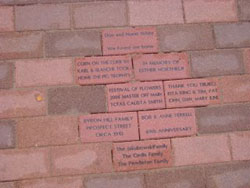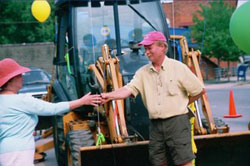Main Street Project
Trumansburg, New York
Source: Pedestrian and Bicycle Information Center (PBIC)

Personalized commemorative bricks helped raise money for the project.
Problem
Several local citizens and community leaders realized that much needed physical changes to their village's pedestrian environment would be the most successful if they unfolded hand-in-hand through a participatory community building process. More than just a sidewalk improvement project, the extensive community participation process inspired a re-visioning of downtown Trumansburg and has led to spin-off projects around town.
Background
In 1995, Paula Horrigan, an area resident and professor of landscape architecture at Cornell University, worked with community leaders and stakeholders to create the Main Street Design Guide, outlining planning, preservation and design vision strategies for Trumansburg's Main Street Corridor. Several years later in 2001, the opportunity came to implement the vision when Horrigan and village Trustee Alan Vogel successfully applied for and received a TEA-21 grant for $800,000. A Main Street Advisory Committee was formed, and the Main Street Project was born. With a small local government, no professional planning staff and a commitment to making the improvements project a truly community-driven process, Horrigan worked with the village to apply for a Cornell Research and Extension Integration Grant to assist the village with facilitating the public process. The $20,000 grant, entitled the Engaged Community Project (ECP), enabled Horrigan and her Cornell colleague, Scott Sears from ILR Extension to assemble the ECP team and hire graduate student, Annalisa Raymer. With the ECP as catalyst, the process of turning a physical infrastructure project into a community engaged, community capacity building process began.
Solution
This ECP project provided the initial leadership to jump-start and facilitate the Main Street Project's unfolding. From the larger Main Street Advisory Committee several subcommittees including the fundraising, design, evaluation, and research teams were formed. Each group drew from resident professionals, citizen "idea-people" and business owners for their members. Each group had different project tasks related to the overall goal of revitalizing Main Street's sidewalks and civic spaces.
Diverse voices, inclusiveness and intergenerational representation were priority concerns of all the groups who used multiple communication and participation modes including public forums posters, church and school assemblies, website and a biweekly column in the local newspaper to get the word out. Several months into the project, acting on the recommendation of the ECP team, the village hired a part-time Main Street Project Assistant and Coordinator of Volunteers, Susan Henninger. Henninger's role, which evolved and adapted to the project's needs, provided crucial continuity in documenting, communicating and activating the Main Street Project.

Celebrating the project.
Using an approach called Participatory Evaluative Action Research (PEAR), the evaluation team gathered community input on all ongoing projects and worked to revise this input into achievable goals and designs. They gave out questionnaires asking participants how they would like to use the public space, how they envision their village, and other opinions on what qualities were valued. The research and advisory teams together prioritized three main questions to investigate: 1) How successful is the main street project in uncovering and addressing concerns of the diverse community? 2) To what extent does the community exercise ownership of the main street project? 3) How does the Main Street Project understand and incorporate community conceptions of the "T-Burg" spirit, identity and place attachment, and the roles of Main Street in the resulting design and its modes of operation?
To answer these questions, the research team conducted interviews with business owners and civic institutions, sent questionnaires to every household along Main Street, and conducted a children's project providing trace paper to draw their desires for the downtown space. As residents often are not sure what specific design goals they want, or know how particular changes would be important to them, surveys often solicited opinions based more on how people envisioned using the space. The many public forums held were not merely places to present developed ideas, but also to actively solicit community input. Breakout groups gave citizens a chance to get involved in the various teams. Sketch artists were on site to give visual form to ideas as they occurred. At one event, hay bales, paint, chalk and set like props (including a clock tower) were used to simulate the changes that would be made to traffic flows, attracting more participants and providing a concrete demonstration to consider. A youth questionnaire was available on the web and at the school, and all active design sessions were recorded. Additionally, the research team observed how people used the streets, noting interactions between cars and people, illegal turns, trucks' turning radiuses, and more. However, a key to the success of the project was the organic nature of the process. All the various teams consulted with each other often as issues arose.
Additional smaller groups worked on a variety of interests. The bus stops worked in conjunction with the Tompkins County Area Transit, who committed to provide funding to improve local bus stops to encourage more riders. Other volunteers developed a "commemorative bulletin" as a sort of historical scrapbook to catalogue the changes going on in the community. Also included in the bulletin were winning youth essays on local history. The project actively recruited youth and families to participate. For example, high school students and 4-H members were able to complete community service requirements through fundraising, an Earth Day event had kids help clean up Main Street, and the local Fourth Grade Architecture Project was made a part of the Design Community Meeting.
Several community disagreements were addressed during the process, including a concern over lost parking, the potential violation of NY State Historic Preservation Office (SHPO) guidelines, and concern over a lost "island" turn-around space. Observation and documentation of parking issues revealed that the parking would not be dramatically impacted, however to be safe, extra care was taken to distribute parking to address everyone's needs. To address SHPO, organizers traveled to Albany and argued that the less conventional proposed improvements, which were trying deliberately to avoid a faux traditionalism, would be consistent with the goals of rehabilitating a living vernacular cultural main street landscape. And finally, community members who were concerned over lost turn around space were brought into the planning dialogue when a community-wide vote resulted in a more flexible solution. The island turnaround space was retained and redesigned so it could easily be closed off during community events.
Further funding was obtained through the State legislature with a $100,000 grant, and many local fundraising events added to the pool. In order to attract donor grants, the fundraising group raised money to provide matching funds by selling personalized commemorative bricks and bluestones, and holding streetscape festivals including the autumn "Corn on the Curb" celebration.
Results
Excellent fundraising resulted in enough funding to assure completion of all the projects in the original plan, as well as additional funds to put towards future improvements. The half-time position of Coordinator of Volunteers was so successful that it was expanded into the role of Community Development Coordinator after five years. Projects completed included sidewalk and curb installation, paving, unique seating installation, retaining walls, tree plantings, curb extensions, storm drains, street lighting, and more.
Most of all, the project which started out as an effort to get the community involved in a few downtown improvements has become a community renewal effort. Additional volunteers have begun projects to develop small parks around town, public access points to the creek, local musician fundraising events, and more. In addition, out of the project emerged two complimentary methods for engaging residents in public placemaking: 1) the Companion Practices approach (a synthesis of civic engagement, community design and action inquiry); and 2) Participatory Evaluative Action Research (PEAR).
Contact
For information on Participatory Evaluative Action Research (PEAR) or Companion Practices, contact:
Annalisa Raymer
alr26@cornell.edu
For information on the Main Street Project, Companion Practices or the Engaged Community Project, contact:
Paula Horrigan
phh3@cornell.edu
Image Source
The Trumansburg Main Street Project. http://mainstreetproject.blogspot.com/




